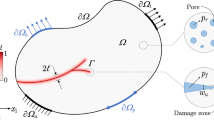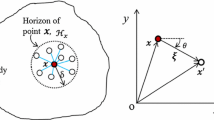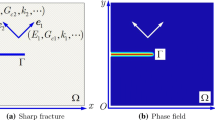Abstract
A novel phase-field model for the propagation of mixed-mode hydraulic fractures, characterized by the formation of mixed-mode fractures due to the interactions between fluids and solids, is proposed. In this model, the driving force for the phase field consists of both tensile and shear components, with the fluid contribution primarily manifesting in the tension driving force. The displacement and pressure are solved simultaneously by an implicit method. The numerical solution’s iterative format is established by the finite element discretization and Newton-Raphson (NR) iterative methods. The correctness of the model is verified through the uniaxial compression physical experiments on fluid-pressurized rocks, and the limitations of the hydraulic fracture expansion phase-field model, which only considers mode I fractures, are revealed. In addition, the influence of matrix mode II fracture toughness value, natural fracture mode II toughness value, and fracturing fluid injection rate on the hydraulic fracture propagation in porous media with natural fractures is studied.
Similar content being viewed by others
References
JIANG, L., SAINOKI, A., MITRI, H. S., MA, N., LIU, H., and HAO, Z. Influence of fracture-induced weakening on coal mine gateroad stability. International Journal of Rock Mechanics and Mining Sciences, 88, 307–317 (2016)
ECONOMIDES, M. J. and NOLTE, K. G. Reservoir Stimulation, Prentice Hall, Englewood Cliffs, NJ (1989)
GHASSEMI, A., TARASOVS, S., and CHENG, A. H. D. A 3-D study of the effects of thermomechanical loads on fracture slip in enhanced geothermal reservoirs. International Journal of Rock Mechanics and Mining Sciences, 44, 1132–1148 (2007)
LI, N. Y., YU, J. J., WANG, C., ZHANG, S. W., LIU, X. K., KANG, J., WANG, Y., and DAI, Y. H. Fracturing technology with carbon dioxide: a review. Journal of Petroleum Science and Engineering, 205, 108793 (2021)
GUO, D. L., JI, L. J., ZHAO, J. Z., and LIU, C. Q. 3-D fracture propagation simulation and production prediction in coalbed. Applied Mathematics and Mechanics (English Edition), 22(4), 385–393 (2001) https://doi.org/10.1023/A:1016337331556
ZHOU, T., WANG, H. B., LI, F. X., LI, Y. Z., ZOU, Y. S., and ZHANG, C. Numerical simulation of hydraulic fracture propagation in laminated shale reservoirs. Petroleum Exploration and Development, 47(5), 1117–1130 (2020)
YI, L. P., WAISMAN, H., YANG, Z. Z., and LI, X. G. A consistent phase field model for hydraulic fracture propagation in poroelastic media. Computer Methods in Applied Mechanics and Engineering, 372, 113396 (2020)
BAKHSHI, E., GOLSANAMI, N., and CHEN, L. J. Numerical modeling and lattice method for characterizing hydraulic fracture propagation: a review of the numerical, experimental, and field studies. Archives of Computational Methods in Engineering, 28, 3329–3360 (2021)
YU, H., XU, W. L., LI, B., MICHEAL, M., WANG, Q., HUANG, M. C., MENG, S. W., LIU, H., and WU, H. A. Hydraulic fracturing and enhanced recovery in shale reservoirs: theoretical analysis to engineering applications. Energy & Fuels, 37, 9956–9997 (2023)
REN, G. and YOUNIS, R. M. An integrated numerical model for coupled poro-hydro-mechanics and fracture propagation using embedded meshes. Computer Methods in Applied Mechanics and Engineering, 376, 113606 (2021)
WANG, Q., YU, H., XU, W. L., HUANG, H. W., LI, F. D., and WU, H. A. How does the heterogeneous interface influence hydraulic fracturing? International Journal of Engineering Science, 195, 104000 (2024)
ZENG, Q., BO, L., LIU, L., LI, X. L., SUN, J. M., HUANG, Z. Q., and YAO, J. Analysis of fracture propagation and shale gas production by intensive volume fracturing. Applied Mathematics and Mechanics (English Edition), 44(8), 1385–1408 (2023) https://doi.org/10.1007/s10483-023-3021-6
TANG, H., WINTERFELD, P. H., WU, Y. S., HUANG, Z. Q., DI, Y., PAN, Z., and ZHANG, J. Integrated simulation of multi-stage hydraulic fracturing in unconventional reservoirs. Journal of Natural Gas Science and Engineering, 36, 875–892 (2016)
LI, X. G., YI, L. P., YANG, Z. Z., LIU, C. Y., and YUAN, P. A coupling algorithm for simulating multiple hydraulic fracture propagation based on extended finite element method. Environmental Earth Sciences, 76, 1–15 (2017)
CAO, T. D., HUSSAIN, F., and SCHREFLER, B. A. Porous media fracturing dynamics: stepwise crack advancement and fluid pressure oscillations. Journal of the Mechanics and Physics of Solids, 111, 113–133 (2018)
WANG, Q., YU, H., XU, W. L., LYU, C. S., ZHANG, J. N., MICHEAL, M., and WU, H. A. Spatial and temporal constraints of the cohesive modeling: a unified criterion for fluid-driven fracture. International Journal for Numerical Methods in Engineering, 124, 2756–2782 (2023)
MIEHE, C., WELSCHINGER, F., and HOFACKER, M. Thermodynamically consistent phase-field models of fracture: variational principles and multi-field FE implementations. International Journal for Numerical Methods in Engineering, 83, 1273–1311 (2010)
JIANG, L., SAINOKI, A., MITRI, H. S., MA, N., LIU, H., and HAO, Z. Influence of fracture-induced weakening on coal mine gateroad stability. International Journal of Rock Mechanics and Mining Sciences, 88, 307–317 (2016)
ZUO, P. and ZHAO, Y. P. Phase field modeling of lithium diffusion, finite deformation, stress evolution and crack propagation in lithium ion battery. Extreme Mechanics Letters, 9, 467–479 (2016)
ZUO, P. and ZHAO, Y. P. A phase field model coupling lithium diffusion and stress evolution with crack propagation and application in lithium ion batteries. Physical Chemistry Chemical Physics, 17, 287–297 (2015)
QIAN, K., PAWAR, A., LIAO, A., ANITESCU, C., WOOD, W. V., FEINBERG, A. W., RABCZUK, T., and ZHANG, Y. J. Modeling neuron growth using isogeometric collocation based phase field method. Scientific Reports, 12, 8120 (2022)
FRANCFORT, G. A. and MARIGO, J. Revisiting brittle fracture as an energy minimization problem. Journal of the Mechanics and Physics of Solids, 46, 1319–1342 (1998)
BOURDIN, B., FRANCFORT, G. A., and MARIGO, J. Numerical experiments in revisited brittle fracture. Journal of the Mechanics and Physics of Solids, 48, 797–826 (2000)
MIEHE, C., HOFACKER, M., and WELSCHINGER, F. A phase field model for rate-independent crack propagation: robust algorithmic implementation based on operator splits. Computer Methods in Applied Mechanics and Engineering, 199, 2765–2778 (2010)
BOURDIN, B., CHUKWUDOZIE, C. P., and YOSHIOKA, K. A variational approach to the numerical simulation of hydraulic fracturing. SPE Annual Technical Conference and Exhibition, Society of Petroleum Engineers, Texas (2012)
MIKELIC, A., WHEELER, M. F., and WICK, T. A phase-field method for propagating fluid-filled fractures coupled to a surrounding porous medium. Multiscale Modeling & Simulation, 13, 367–398 (2015)
MIEHE, C., MAUTHE, S., and TEICHTMEISTER, S. Minimization principles for the coupled problem of Darcy-Biot-type fluid transport in porous media linked to phase field modeling of fracture. Journal of the Mechanics and Physics of Solids, 82, 186–217 (2015)
SANTILLÁN, D., JUANES, R., and CUETO-FELGUEROSO, L. Phase field model of hydraulic fracturing in poroelastic media: fracture propagation, arrest, and branching under fluid injection and extraction. Journal of Geophysical Research: Solid Earth, 123, 2127–2155 (2018)
ALDAKHEEL, F. A microscale model for concrete failure in poro-elasto-plastic media. Theoretical and Applied Fracture Mechanics, 107, 102517 (2020)
ZHANG, X., SLOAN, S. W., VIGNES, C., and SHENG, D. A modification of the phase-field model for mixed mode crack propagation in rock-like materials. Computer Methods in Applied Mechanics and Engineering, 322, 123–136 (2017)
SCHLÜTER, A., WILLENBÜCHER, A., KUHN, C., and MULLER, R. Phase field approximation of dynamic brittle fracture. Computational Mechanics, 54, 1141–1161 (2014)
AMBATI, M., GERASIMOV, T., and LORENZIS, L. D. Phase-field modeling of ductile fracture. Computational Mechanics, 55, 1017–1040 (2015)
MIEHE, C., HOFACKER, M., SCHÄNZEL, L. M., and ALDAKHEEL, F. Phase field modeling of fracture in multi-physics problems, part II: coupled brittle-to-ductile failure criteria and crack propagation in thermo-elastic-plastic solids. Computer Methods in Applied Mechanics and Engineering, 294, 486–522 (2015)
MIEHE, C. and SCHÄNZEL, L. M. Phase field modeling of fracture in rubbery polymers, part I: finite elasticity coupled with brittle failure. Journal of the Mechanics and Physics of Solids, 65, 93–113 (2014)
XU, W. L., YU, H., ZHANG, J. N., LYU, C. S., WANG, Q., MICHEAL, M., and WU, H. A. Phase-field method of crack branching during SC-CO2 fracturing: a new energy release rate criterion coupling pore pressure gradient. Computer Methods in Applied Mechanics and Engineering, 399, 115366 (2022)
ARRIAGA, M. and WAISMAN, H. Stability analysis of the phase-field method for fracture with a general degradation function and plasticity induced crack generation. Mechanics of Materials, 116, 33–48 (2018)
SHEN, R. L., WAISMAN, H., and GUO, L. Fracture of viscoelastic solids modeled with a modified phase field method. Computer Methods in Applied Mechanics and Engineering, 346, 862–890 (2019)
LI, V. C. Mechanics of shear rupture applied to earthquake zones. Fracture Mechanics of Rock, Academic Press, New York (1986)
BIOT, M. A. Mechanics of deformation and acoustic propagation in porous media. Journal of Applied Physics, 33(4), 1482–1498 (1962)
ZHANG, D., YI, L., YANG, Z., LI, X., and ZHANG, F. Phase field model for simulating hydraulic fracture propagation and oil-water two-phase flow in reservoir. Computer Methods in Applied Mechanics and Engineering, 404, 115838 (2023)
INGRAFFEA, A. R. and HEUZE, F. E. Finite element models for rock fracture mechanics. International Journal for Numerical and Analytical Methods in Geomechanics, 4(1), 25–43 (1980)
CHEN, Y., NAGAYA, Y., and ISHIDA, T. Observations of fractures induced by hydraulic fracturing in anisotropic granite. Rock Mechanics and Rock Engineering, 48(4), 1455–1461 (2015)
DENG, B., YIN, G., LI, M., ZHANG, D., LU, J., LIU, Y., and CHEN, J. Feature of fractures induced by hydrofracturing treatment using water and L-CO2 as fracturing fluids in laboratory experiments. Fuel, 226, 35–46 (2018)
YANG, C. X., YI, L. P., YANG, Z. Z., and LI, X. G. Numerical investigation of the fracture network morphology in multi-cluster hydraulic fracturing of horizontal wells: a DDM-FVM study. Journal of Petroleum Science and Engineering, 215, 110723 (2022)
WARPINSKI, N. R. and TEUFEL, L. W. Influence of geologic discontinuities on hydraulic fracture propagation. Journal of Petroleum Technology, 39, 209–220 (1987)
ZHOU, J., CHEN, M., JIN, Y., and ZHANG, G. Q. Analysis of fracture propagation behavior and fracture geometry using a tri-axial fracturing system in naturally fractured reservoirs. International Journal of Rock Mechanics and Mining Sciences, 45, 1143–1152 (2008)
ZHUANG, L., KIM, K. Y., JUNG, S. G., DIAZ, M., and MIN, K. B. Effect of water infiltration, injection rate and anisotropy on hydraulic fracturing behavior of granite. Rock Mechanics and Rock Engineering, 52, 575–589 (2019)
WANG, Y., LI, X., and TANG, C. A. Effect of injection rate on hydraulic fracturing in naturally fractured shale formations: a numerical study. Environmental Earth Sciences, 75, 1–16 (2016)
LI, Y., HU, W., ZHANG, Z., ZHANG, Z., SHANG, Y., HAN, L., and WEI, S. Numerical simulation of hydraulic fracturing process in a naturally fractured reservoir based on a discrete fracture network model. Journal of Structural Geology, 147, 104331 (2021)
Author information
Authors and Affiliations
Corresponding author
Ethics declarations
Conflict of interest The authors declare no conflict of interest.
Additional information
Project supported by the National Natural Science Foundation of China (No. 42202314)
Rights and permissions
About this article
Cite this article
Zhang, D., Yi, L., Yang, Z. et al. A phase-field model for simulating the propagation behavior of mixed-mode cracks during the hydraulic fracturing process in fractured reservoirs. Appl. Math. Mech.-Engl. Ed. 45, 911–930 (2024). https://doi.org/10.1007/s10483-024-3113-9
Received:
Revised:
Published:
Issue Date:
DOI: https://doi.org/10.1007/s10483-024-3113-9




